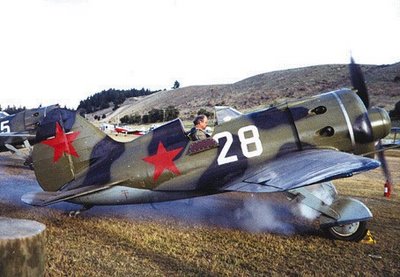

Polikarpov’s I-16 Fighter – It’s Forerunners and Progeny
Red Star Volume 3
By Yefim Gordon and Keith Dexter
© 2001 Midlands Press and Specialty Press
Reviewed by Ned Barnett
(review copy provided by Specialty Press)
This book initially came out in 2001 – and it was a great addition to the literature at that time. However, since 2001, restored I-16s are once again flying, stirring a new level of interest in these remarkable transitional-era fighter aircraft. Beyond that, Eduard, Trumpeter and a half-dozen other kit manufacturers have issued great new kits of the I-16 and its immediate predecessors, the I-15 and I-153 biplane fighters. That influx of new Soviet fighter kits makes this book well worth another look – if you don’t have it, and if you’re planning to build one of these great kits (I plan to build five of them), this book is an absolute godsend.
It’s 126 pages long – 20 of those pages are side-view line drawings and side-view color plates – lots and lots of color plates, illustrating just how many color schemes are available to modelers.
Mostly, however, this book is chock-full of detailed photos – lots and lots of photos – along with enough text to help you make sense of both the photos and the almost-bewildering number of models of I-16s that were manufactured.
Why does this matter? At the time of it’s entry into service, the I-16 was perhaps the most advanced fighter aircraft in the world – it did in the early 1930s what the MiG-15 did in the early 1950s – it catapulted Soviet fighter aircraft into the forefront of world development. Initially built with an enclosed cockpit, the I-16 was among the first operational cantilever monoplane fighters with retractable landing gear. The I-16 also carried more than the then-standard two rifle-caliber machine guns. With streamlining, strength and raw power, the I-16 set the standard for all the fighters that followed, right on through to the beginning of the jet age.
The I-16 was a dominant fighter for most of the Spanish Civil War – while early Messerschmitt Bf-109s came in late in the war and offered some performance advantages over the I-16, pilot skill was often the margin between success and failure. Later, in the far-eastern border clash between Imperial Japanese forces based in the puppet state of Manchukuo (occupied Manchuria) and Soviet armed forces based in Mongolia – the Khalkhin Gol “incident” – the I-16 proved more than a match for the supremely maneuverable Nakajima Ki-27 fighter.
However, by 1941, the I-16 was long past its prime – but for a variety of reasons, the Soviets didn’t have enough of the next- replacement aircraft in squadron service, and the now-obsolete I-16 had to soldier on. Many brave Soviet pilots died in 1941 and 1942 – and in some cases, into the early months of 1943 – for the “crime” of being assigned to front-line fighter planes that should have been relegated to ground attack or advanced-training duties. In spite of the I-16’s antique-status, more than a few exceptional pilots actually racked-up impressive success rates while flying these museum-piece fighters. These include Red Banner Baltic Fleet Lieutenant Senior Grade G. Tsokolayev, Lieutenant Senior Grade G. G. Guryakov, five-victory ace Lt. Krichevskiy, another well-known ace – Boris F. Safonov – and Hero of the Soviet Union Vasiliy Golubev.
The long and the short of the I-16 is this: In it’s prime, this aircraft was the best in the world at what it did; and even though it was used long after it should have been retired, in the hands of a skilled pilot, the plane could still hold it’s own in combat with the vaunted German Luftwaffe.
This book – Polikarpov’s I-16 Fighter – captures the essence of this remarkable aircraft. The narrative text tells the story if it’s creation, development and combat career. The illustrations will appeal to aircraft history/technology buffs and modelers alike. Strongly recommended!
No comments:
Post a Comment